|
| Key |
|---|
 |
Local African American firsts |
 |
University of Texas at Austin (UT) facts |
 |
Local desegregation facts |
 |
Statewide desegregation facts |
 |
National desegregation facts |
Note: The Austin American-Statesman newspaper had several name changes over the five decades covered in this timeline. The variations reflect usage for that time—Austin Statesman, The Austin Statesman, The Austin-Statesman, The Austin American, The Austin American-Statesman, American Statesman, The American-Statesman, Austin American-Statesman.
|
overview |
1940s |
1950s |
1960s |
1970s |
1980s |
all
|
1940
|
 |
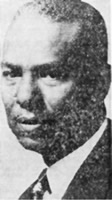 Arthur De Witty becomes the first African American to be appointed to a Travis County Grand jury. [AF-Biography-Arthur De Witty; The Austin American, “City Civil Rights Leader Succumbs,” December 03, 1968]
Arthur De Witty becomes the first African American to be appointed to a Travis County Grand jury. [AF-Biography-Arthur De Witty; The Austin American, “City Civil Rights Leader Succumbs,” December 03, 1968] |
|
|
1946
|
|
|
1948
|
 |
Representatives of the Campus Guild at The University of Texas at Austin congratulates Hazel Scott, a nationally known African American pianist, for refusing to perform before a segregated audience at Gregory Gym. [AF-Segregation-Public Schools-S1700 (1)-University of Texas; The Austin American, “Campus Guild Defends Artist,” November 17, 1948] |
|
|
1950
|
 |
Bergstrom Air Force Base’s “Negro” baseball players are informed that they can not play in an exhibition game against the Austin High School Maroons being held at House Park athletic field. The game is cancelled because of a deed restriction prohibiting African Americans from participating in sports activities there. [AF-Segregation-Public Schools-S1700 (2)-1950s; The Austin Statesman, “Baseball Game Off on Account of ‘Color’ Line,” April 06, 1950] |
 |
After four and one half years of legal battles, Heman Marion Sweatt registers at The University of Texas at Austin. [AF-Segregation-Public Schools-S1700 (1)-University of Texas; The Austin Statesman, “Sweatt Signed at Law School,” September 19, 1950] |
|
|
1951
|
 |
 Austin City Council abolishes racial segregation in the Main Library and the Carver Branch Library in December. [AF-Segregation-Public Schools-S1700 (2)-1950s; The Austin Statesman, “New Libraries Held Needed,” December 28, 1951]
Austin City Council abolishes racial segregation in the Main Library and the Carver Branch Library in December. [AF-Segregation-Public Schools-S1700 (2)-1950s; The Austin Statesman, “New Libraries Held Needed,” December 28, 1951] |
|
|
1953
|
 |
August Novel Swain (1927-2006) becomes first African American to receive a master’s degree from the School of Social Work at The University of Texas at Austin. [Austin American-Statesman, Obituaries, May 26, 2006] |
 |
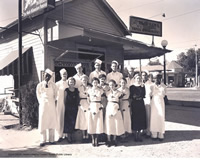 Harry Akins, owner of the Night Hawk Restaurant, is “instrumental in the desegregation of most of Austin’s major restaurants.” [AF-Segregation-Public Schools-S1700 (2)-1950s; The Austin American, “Akins Opposes Hasty Actions,” October 02, 1953]
Harry Akins, owner of the Night Hawk Restaurant, is “instrumental in the desegregation of most of Austin’s major restaurants.” [AF-Segregation-Public Schools-S1700 (2)-1950s; The Austin American, “Akins Opposes Hasty Actions,” October 02, 1953] |
 |
Mrs. Myrtle Washington is arrested for refusing to move to the rear of the bus when asked by an Austin Transit Company bus driver. The Austin Chapter of the National Association for the Advancement of Colored People (NAACP) represents Mrs. Washington who is charged with violating the 1945 Jim Crow law requiring Blacks to sit at the rear of the bus. [AF-Civil Rights-National Association for the Advancement of Colored People-C4600 (1); The Austin American, “Jim Crow Test Looms in Arrest,” August 01, 1953] |
|
|
1954
|
 |
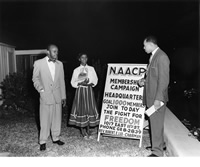 The Austin Chapter of the NAACP draws up petitions asking for the “immediate abolition” of segregation in Austin public schools. [AF-Segregation-Public Schools-S1700 (2)-1954; The Austin American, “School Desegregation Drive Looms,” July 08, 1954]
The Austin Chapter of the NAACP draws up petitions asking for the “immediate abolition” of segregation in Austin public schools. [AF-Segregation-Public Schools-S1700 (2)-1954; The Austin American, “School Desegregation Drive Looms,” July 08, 1954] |
|
|
1955
|
 |
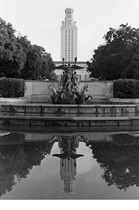 In a unanimous decision, The University of Texas Board of Regents votes to admit African American undergraduate students starting in the fall semester, 1956. [AF-Segregation-Public Schools-S1700 (1)-University of Texas; The Austin-Statesman, “U.T. Regents Vote To Admit Negroes,” July 08, 1955]
In a unanimous decision, The University of Texas Board of Regents votes to admit African American undergraduate students starting in the fall semester, 1956. [AF-Segregation-Public Schools-S1700 (1)-University of Texas; The Austin-Statesman, “U.T. Regents Vote To Admit Negroes,” July 08, 1955] |
 |
The Austin School Board orders that racial barriers be removed at the city’s high schools. [AF-Segregation-Public Schools-S1700 (2)-1950s; The American-Statesman, “Change Starting At Top,” August 09, 1955] |
 |
Governor Allan Shivers warns Texas school districts that if they desegregate, they may be “jeopardizing the funds they are eligible to receive under the Gilmer-Aikin program if integration is prematurely effected.” [AF-Segregation-Public Schools-S1700 (2)-1950s; The Austin Statesman, “Schools Risk Fund Loss by Integration,” August 21, 1955] |
 |
African American couples attend the first integrated dance jointly sponsored by Stephen F. Austin and McCallum High Schools. “There was no mixed dancing reported.” [AF-Segregation-Public Schools-S1700 (2)-1950s; The American-Statesman, “Negro Couples Attend McCallum-SFA Dance,” September 11, 1955] |
 |
On Oct. 7, L. Clifford Davis, an African American lawyer from Fort Worth, files a class action lawsuit in the United States Federal Court requesting the integration and admittance of black high school students into Mansfield High School, in Mansfield, Texas just southeast of Fort Worth. [Ladino, Robyn Duff, Desegregating Texas Schools: Eisenhower, Shivers, and the Crisis at Mansfield High. 1997] |
 |
Arthur De Witty, public relations officer for the Austin Chapter of the NAACP in Austin, secures an attorney to aid in the case of Mrs. Howellen Taylor who has been charged with “violating the state Jim Crow Law” by refusing a driver’s request to move to the back of the bus. [AF-Segregation-Public Schools-S1700 (2)-1950s; The Austin Statesman, “Segregation On Busses Gets Appeal,” December 16, 1955] |
 |
An Interstate Commerce Commission order ended segregation on interstate trains and busses in Texas. [AF-Segregation-Public Schools-S1700 (2)-1950s; The Austin American, “ICC Order ‘Integrates’ Terminals,” December 26, 1955] |
 |
Austin Chapter of the NAACP public relations officer, Arthur DeWitty, announces the intention of the organization to take the case of Mrs. Howellen Taylor to the Texas Supreme Court in an attempt to get clarification of the law on segregation on public conveyances “if necessary.” [AF-Segregation-Public Schools-S1700 (2)-1955; The Austin American, “NAACP Pushes City Test Case,” December 26, 1955] |
 |
In December, Rosa Parks refuses to give up her seat to a white man, an event that sparked the Montgomery, Alabama, bus boycott and the beginning of the Civil Rights Movement [Timelines of African-American History: 500 Years of Black Achievement by Thomas Dale Cowan and Jack Maguire, 1995] |
|
|
1956
|
 |
On June 7, the United States Supreme Court and the Texas Supreme Court upheld and supported the constitutional rights of African American teenagers to attend Mansfield High School. On August 27, the Federal District Court ordered Mansfield ISD to “immediately integrate the high school.” [Ladino, Robyn Duff, Desegregating Texas Schools: Eisenhower, Shivers, and the Crisis at Mansfield High. 1997] |
 |
Travis County attorney dismisses test case challenging segregated busses in Texas. [AF-Segregation-Public Schools-S1700 (2)-1950s; The Austin American, “Austin Bus Test Case Dismissed,” February 14, 1956] |
 |
The University of Texas’s Inter-Co-op Council voted unanimously to accept African American students in cooperative housing. [AF-Segregation-Public Schools-S1700 (1) -University of Texas; The Austin Statesman, “UT CO-OP Council Votes Integration: Negroes Acceptable In Housing,” March 07, 1956] |
 |
Because of the fire at Allan Junior High School, the desegregation of Austin’s junior high schools is delayed for a year. [AF-Segregation-Public Schools-S1700 (2)-1950s; The Austin Statesman, “Junior High Segregation To Continue Next Year,” May 15, 1956] |
 |
Thirteen African American students become the first to integrate Austin’s high schools-seven at Stephen F. Austin High; five at William B. Travis High; and one at A.N. McCallum High. [AF-Segregation-Public Schools-S1700 (2)-1950s; The Austin Statesman, “3 High Schools Get 13 Negroes,” September 2, 1955] |
|
|
1957
|
 |
The status of school desegregation in Texas is described as “remarkably quiet.” Houston, Dallas, and Fort Worth continue to be segregated with integration lawsuits pending. [“Integration: It’s Slow, ‘Remarkably Quiet,’” c. 1957] |
 |
University of Texas student Barbara Smith (today Barbara Smith Conrad) is removed from the lead role in the opera “Dido and Aeneas” because she is black. [AF-Segregation-Public Schools-S1700 (1) -University of Texas; The Austin American, “In U.T. Opera Role: Negro Silent About Ouster,” May 8, 1957] |
 |
Integration of Austin’s junior high schools is postponed again due to overcrowding. [AF-Segregation-Public Schools-S1700 (2)-1950s; The Austin Statesman, “Crowed Schools Delay Junior High Integration: Board Postpones Act Until Situation Eases,” June 11, 1957] |
|
|
1958
|
 |
Bishop John E. Hines of the Episcopal Diocese of Texas calls for racial integration and equality in local congregations and in Episcopalian schools and camps.
[AF-Segregation-Public Schools-S1700 (2)-1950s; The Austin-American, “Integrated Schools, Camps, Hines Plea,” January 25, 1958] |
 |
With the approval of the Episcopal Diocese of Texas, Trustees of St. Stephen’s School in Austin vote to admit students of all races. [AF-Segregation-Public Schools-S1700 (2)-1950s; The American-Statesman, “St. Stephen’s Get Approval To Integrate,” January 26, 1958] |
 |
When fourteen-year-old Sandra Kay Hall is admitted into Allan Junior High, she became the first African American in Austin to attend a white junior high school. [AF-Segregation-Public Schools-S1700 (2)-1950s; The Austin American, “Up 1003: Schools Open For 27,505,” September 03, 1958] |
|
|
1959
|
 |
Louis Major Barrow, employee of American National Bank, becomes first African American in Austin to man a teller window. [AF-Segregation-Public Schools-S1700 (2)-1950s; Austin American-Statesman, “Rough Road is Traveled,” April 29, 1984] |
 |
The Delta Xi Chapter of Alpha Kappa Alpha Sorority, Inc. is the first black Greek Letter Organization established at The University of Texas at Austin, May 16. [AF-Alpha Kappa Alpha-A1300 (27)] |
|
|
1960
|
 |
 A delegation of leaders from the African American community that included Arthur DeWitty, Rev. B. L. McCormick, Mrs. Friendly R. Rice, and Dr. Beadie E. Conner requests that the two “For Whites Only” signs be removed from the basement of the Travis County Courthouse. [AF-Segregation-Public Schools-S1700 (2)-1960; The Austin Statesman, “Courthouse Integration Complete,” March 01, 1960]
A delegation of leaders from the African American community that included Arthur DeWitty, Rev. B. L. McCormick, Mrs. Friendly R. Rice, and Dr. Beadie E. Conner requests that the two “For Whites Only” signs be removed from the basement of the Travis County Courthouse. [AF-Segregation-Public Schools-S1700 (2)-1960; The Austin Statesman, “Courthouse Integration Complete,” March 01, 1960] |
 |
 White and African American students from several area colleges picket businesses on Congress Avenue urging “integration of lunch counters.” [AF-Segregation-Public Schools-S1700 (2)-1960; The Dallas Morning News, “Student Pickets in Austin Ask for Integration,” April 28, 1960]
White and African American students from several area colleges picket businesses on Congress Avenue urging “integration of lunch counters.” [AF-Segregation-Public Schools-S1700 (2)-1960; The Dallas Morning News, “Student Pickets in Austin Ask for Integration,” April 28, 1960] |
 |
African American and white University of Texas students at Austin stage three demonstrations against the segregated Texas Theater on the main campus. [AF-Segregation-Public Schools-S1700 (1)-University of Texas; The Texas Observer, “Students Demonstrate Against Texas Theater,” December 09, 1960s] |
 |
The Travis County Grand Jury indicts University students John Winborn and William H. McKnight for setting off a homemade bomb outside an integrationist meeting at The University of Texas YMCA. [AF-Segregation-Public Schools-S1700 (1)-University of Texas; The American-Statesman, “Pair Indicted in Bombing,” December 04, 1960] |
 |
Integrationists conduct stand-ins at the Texas and Varsity Theaters on the Drag near The University of Texas campus area. [AF-Segregation-Public Schools-S1700 (2)-1960s; The Austin American, “Stand-ins Continue on Drag,” December 14, 1960] |
|
|
1961
|
 |
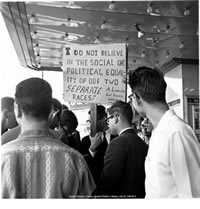 The Texas, Varsity, Paramount and State Theaters are targets of stand-ins by segregationists. [AF-Segregation-Public Schools-S1700 (2)-1960s; The Austin American, “450 Protest at Theaters,” February 13, 1961]
The Texas, Varsity, Paramount and State Theaters are targets of stand-ins by segregationists. [AF-Segregation-Public Schools-S1700 (2)-1960s; The Austin American, “450 Protest at Theaters,” February 13, 1961] |
 |
Rev. Buck, a priest in charge of St. James Episcopal Church, carried a sign stating: “The segregation policy of St. Andrew’s Episcopal School is unfair to Negro Episcopals. Do not support segregation.” [AF-Segregation-Public Schools-S1700 (2)-1960s; The Austin Statesman, “Pickets Walk in Front of Episcopal School,” April 20, 1961] |
 |
The sixth grade of the Austin Public Schools integrates in September for the first time. [AF-Segregation-Public Schools-S1700 (2)-1960s; The Austin American, “6th Grade Integration Approved,” July 11, 1961] |
 |
Five hundred African American students are eligible to transfer to white schools as a result of the Austin ISD Board of Education’s decision to continue its desegregation policy into the elementary schools. [AF-Segregation-Public Schools-S1700 (2)-1960s; The Austin Statesman, “500 Negro 6th Graders Can Enter White Schools,” July 11, 1961] |
 |
The Texas and Varsity Theaters located on the Drag near The University of Texas campus integrate under a newly adopted integration policy. [AF-Segregation-Public Schools-S1700 (2)-1960s; The Austin Statesman, “2 Theaters Integrated For Students,” September 05, 1961] |
|
|
1962
|
 |
The fifth grade is the next level to integrate following a “grade-by-grade downward progression.” [AF-Segregation-Public Schools-S1700 (2)-1960s; The Austin American, “Fifth Graders Desegregated,” September 05, 1962] |
 |
Black students at The University of Texas extend an invitation to civil rights leader Martin Luther King to assist them with the full integration of all university facilities, including dormitories and intercollegiate athletics. [AF-Segregation-Public Schools-S1700 (1)-University of Texas; The Dallas Morning News, “Officials at UT Disturbed by Report Dr. King Invited,” October 20, 1962] |
|
|
1963
|
 |
University of Texas and Huston-Tillotson College students picket Piccadilly Cafeteria in downtown Austin for not serving African Americans. [AF-Segregation-Public Schools-S1700 (2)-1960s; The Austin Statesman, “Downtown Cafeteria Picketed,” February 14, 1964] |
 |
Houston public swimming pools integrate, June 7th. Houston Mayor Lewis Cutrer orders that Houston municipal pools be open to blacks. The city had already desegregated all public buildings in 1962. Parks and municipal golf courses had previously been opened to all races. City pools are the last of the municipal facilities to eliminate segregation. [Scrapbook Collection: News Clippings Recreation Department 1963; AR Z.025] |
 |
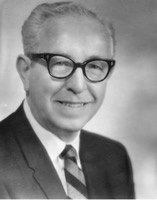 Harry Akins, owner of the Night Hawk Restaurants Inc. of Austin and San Antonio, met with a group of Austin restaurant owners to discuss integration. Seventeen of the restaurant owners signed pledges to make their facilities available to all persons “regardless of race, color or creed.” Akins is one of 100 business men from around the nation-and five from Texas-who attended the White House conference on the need for greater integration of facilities available to the public. When at the conference U.S. Attorney General Robert Kennedy read the list of Texas cities that have made considerable progress in the integration of public facilities, Austin was not among them. [AF-Segregation-Public Schools-S1700 (2)-1960s; The Austin Statesman, “City Restaurants Sign Integrate Pact,” June 06, 1963]
Harry Akins, owner of the Night Hawk Restaurants Inc. of Austin and San Antonio, met with a group of Austin restaurant owners to discuss integration. Seventeen of the restaurant owners signed pledges to make their facilities available to all persons “regardless of race, color or creed.” Akins is one of 100 business men from around the nation-and five from Texas-who attended the White House conference on the need for greater integration of facilities available to the public. When at the conference U.S. Attorney General Robert Kennedy read the list of Texas cities that have made considerable progress in the integration of public facilities, Austin was not among them. [AF-Segregation-Public Schools-S1700 (2)-1960s; The Austin Statesman, “City Restaurants Sign Integrate Pact,” June 06, 1963] |
 |
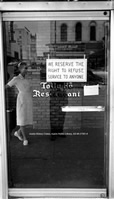 The Austin Chamber of Commerce adopts a resolution recommending the “immediate and complete integration of all public facilities.” [AF-Segregation-Public Schools-S1700 (2)-1960s; The Austin Statesman, “City Action Is Praised,” June 13, 1963]
The Austin Chamber of Commerce adopts a resolution recommending the “immediate and complete integration of all public facilities.” [AF-Segregation-Public Schools-S1700 (2)-1960s; The Austin Statesman, “City Action Is Praised,” June 13, 1963] |
 |
The Austin School Board lifts the remaining barriers to complete integration. [AF-Segregation-Public Schools-S1700 (2)-1960s; The Austin Statesman, “Grades 1 Through 12 Affected in September,” June 15, 1963] |
 |
The Austin Ice Palace at 3800 Airport Blvd. removes “white only” policy. [AF-Segregation-Public Schools-S1700 (2)-1960s; The Austin-American, “Rink Drops Racial Bars,” June 19, 1963] |
 |
 Citywide playgrounds are integrated quietly and smoothly during the summer season. For the first time, Rosewood Recreation District (the African American district) participates in all citywide events. Black and white players compete together in baseball tournaments. [AF-Segregation-Public Schools-S1700 (2)-1960s; The Austin Statesman, “Integration of City’s Playgrounds Smooth,” September 24, 1963]
Citywide playgrounds are integrated quietly and smoothly during the summer season. For the first time, Rosewood Recreation District (the African American district) participates in all citywide events. Black and white players compete together in baseball tournaments. [AF-Segregation-Public Schools-S1700 (2)-1960s; The Austin Statesman, “Integration of City’s Playgrounds Smooth,” September 24, 1963] |
|
|
1964
|
 |
The Civil Rights Act of 1964 “enforces the constitutional right to vote, to confer jurisdiction upon the district courts of the United States to provide injunctive relief against discrimination in public accommodations, to authorize the Attorney General to institute suits to protect constitutional rights in public facilities and public education, to extend the Commission on Civil Rights, to prevent discrimination in federally assisted programs, to establish a Commission on Equal Employment Opportunity, and for other purposes.” [http://usinfo.state.gov/usa/ infousa/laws/majorlaw/civilr19.htm] |
 |
The University of Texas Board of Regents removes the last vestige of segregation on campus when it voted 6-1 to desegregate dormitories. [AF-Segregation-Public Schools-S1700 (1)-University of Texas; The Daily Texan, “Regents Drop Dormitory Segregation; University Becomes Totally Integrated,” May 17, 1964] |
 |
Mrs. Cora Eiland Hicks, who in 1953 became the first African American to hold a position higher than a clerk at The University of Texas, is appointed to the University faculty as a teaching assistant in the English Department. [AF-Segregation-Public Schools-S1700 (1) -University of Texas; The Texas Observer, “UT Promotes Negro Woman to Faculty,” June 09, 1964] |
 |
Dr. Ervin Sewell Perry (1935-1970) becomes the first African American to be appointed to the faculty of a previously all-white southern university when he begins teaching at The University of Texas at Austin in September. He is appointed to the position of assistant professor of engineering. [The Austin American, “First Negro Professor at UT Dies At Age 34,” December 15, 1970; http://www.lib.utexas.edu/pcl/history/perry.html] |
 |
Three African American teachers integrate for the first time the faculty of two Austin high schools. William Akins, world history teacher, integrates Johnston High School; B.T. Snell, seventh grade English and social studies, along with English teacher Narveline Drennan, integrate Allan Junior High School. [AF-Segregation-Public Schools-S1700 (2)-1960s; The Austin American, “Austin Faculty Is Integrated,” September 11, 1964] |
|
|
1965
|
 |
The Civil Rights Act of 1965 “forbids racial, religious, and gender discrimination in public accommodations; allows withholding of federal grants and contracts from violators; forbids discrimination by employers; and empowers the Justice Department to sue violators.” [http://www.humboldt.edu/ ~go1/hist111/civilrights.html] |
 |
The 40 Acres Club at The University of Texas admits Black members for the first time. [Marsh Durden, Almetris. Overcoming: A History of Black Integration at The University of Texas at Austin. 1979; A 378.76431 DU] |
 |
A white boy and an African American girl “apply” for a marriage license against Texas law that prohibits interracial marriage. [AF-Segregation-Public Schools-S1700 (2)-1960s; The Austin Statesman, “White Boy, Negro Girl ‘Apply’ For Marriage License,” October 07, 1965] |
 |
 The Cowboy Minstrel Show votes out blackface in its annual performances. [Marsh Durden, Almetris. Overcoming: A History of Black Integration at The University of Texas at Austin. 1979; A 378.76431 DU]
The Cowboy Minstrel Show votes out blackface in its annual performances. [Marsh Durden, Almetris. Overcoming: A History of Black Integration at The University of Texas at Austin. 1979; A 378.76431 DU] |
|
|
1966
|
 |
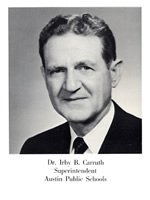 On May 10th, Superintendent Irby B. Carruth issues a letter to all parents announcing that Austin Independent School District would “no longer have schools for children of different races.” The U.S. Office of Education had accepted the school desegregation plan, whose adoption was begun in 1955 and completed in 1963. Now all students had to make a “choice.” [AF-Segregation-Public Schools-S1700 (2)-1960s]
On May 10th, Superintendent Irby B. Carruth issues a letter to all parents announcing that Austin Independent School District would “no longer have schools for children of different races.” The U.S. Office of Education had accepted the school desegregation plan, whose adoption was begun in 1955 and completed in 1963. Now all students had to make a “choice.” [AF-Segregation-Public Schools-S1700 (2)-1960s] |
|
|
1967
|
 |
All [Old] Anderson High School area students are given the choice of attending any high school in district. [AF-Segregation-Public Schools-S1700 (2)-1977; The Austin American-Statesman (Evening Edition), “Desegregation Chronology,” November 22, 1977] |
 |
Austin City Council passes the Fair Housing Ordinance, outlawing discrimination on the basis of race, color, or religion in selling, renting, and financing housing.
[Marsh Durden, Almetris. Overcoming: A History of Black Integration at the University of Texas at Austin. 1979; A 378.76431 DU] |
 |
Douglas Washington becomes the first African American to pledge a white fraternity at The University of Texas. [AF-Segregation-Public Schools-S1700 (1)-University of Texas; The Austin-American, “Fraternity Has Negro As Pledge,” October 11, 1968] |
 |
A U.S. Department of Health, Education, and Welfare survey team declares Austin ISD in noncompliance with the Civil Rights Act. [AF-Segregation-Public Schools-1700 (2)-1970s; The Austin American-Statesman (Evening Edition), “Desegregation Chronology,” November 22, 1977] |
|
|
1968
|
 |
 In April, Wilhelmina Fitzgerald Delco is elected to the Austin ISD Board of Trustees, becoming the first African American in Austin to be elected to such a position. [AF-Biography-Delco, Exalton Alfonso, Jr.]
In April, Wilhelmina Fitzgerald Delco is elected to the Austin ISD Board of Trustees, becoming the first African American in Austin to be elected to such a position. [AF-Biography-Delco, Exalton Alfonso, Jr.] |
 |
Both black and white students hold a campus memorial service, honoring the life of slain civil rights leader Dr. Martin Luther King, Jr., that includes a march to the Texas Capitol building and a service sponsored by the Austin Council of Churches at Municipal Auditorium. [Marsh Durden, Almetris. Overcoming: A History of Black Integration at The University of Texas at Austin. 1979; A 378.76431 DU] |
|
|
1969
|
 |
The Department of Black History and Afro-American Studies is founded at The University of Texas at Austin and headed by John Warfield. [Simond, Ada. Looking Back, 1984; A 976.431. Si AA] |
 |
The pattern of integration in Austin is black to white schools because the numbers of white schools outnumber black. Therefore, Austin school trustees set goals to have one white teacher for every black teacher in previously all black schools. A goal of 50-50 mixed faculties will near reality when school opens in September 1969. [AF-Segregation-Public Schools-S1700 (2)-1960s; The Austin-American Statesman, “Black into White is Integration Pattern.” February 26, 1969] |
 |
All black students in predominantly black areas are given choice of attending any school. [AF-Segregation-S1700 (2)-Public Schools-1975; The American-Statesman, “Desegregation in Austin,” August 17, 1975] |
 |
The Austin Independent School District’s desegregation plan is rejected for the third time by the Department of Health, Education, and Welfare. [AF-Segregation-Public Schools-S1700 (2)-1975; The American-Statesman, “Desegregation in Austin,” August 17, 1975] |
|
|
1970
|
 |
The Department of Health, Education and Welfare finds that the Austin ISD is in violation of the 1964 Civil Rights Act because of the existence of eight predominantly black schools. [AF-Segregation-Public Schools-S1700 (2)-1970; Austin American- Statesman, “School Hearing Concludes,” January 24, 1970] |
 |
The Austin ISD School Board votes unanimously to reject Plan C, a desegregation plan that would have classified Mexican American children as white. [AF-Segregation-Public Schools-S1700 (2)-1970; The Echo, “East Austin Wins First Round in School Board Fight,” May 19, 1970] |
 |
The federal government brings suit against the Austin ISD for alleged failure to comply with desegregation guidelines. [AF-Segregation-Public Schools-S1700 (2)-1970; Austin American-Statesman, “Integration Suit Filed on Austin,” August 08, 1970] |
 |
In an effort to meet federal desegregation guidelines, the school board approves a new teacher crossover plan, which will make the faculty makeup in each school comparable to the composition of the student body. [AF-Segregation-Public Schools-S1700 (2)- 1970; The Austin American, “108 Teachers Will ‘Cross Over&rsquo,” August 13, 1970] |
 |
Anderson High welcomes Mexican American and Anglo student transfers. [AF-Segregation-Public Schools-S1700 (2)-1970s; The Austin American, “Austin Schools Begin Court-Ordered Mixins,” September 01, 1970] |
 |
Two-way busing as the beginning of a school integration problem is advocated by many of the nearly 100 citizens at a public forum. [AF-Segregation-Public Schools-S1700 (2)-1970; The Austin American, “Bus Plan Advocated By Group,” October 09, 1970] |
 |
The Austin ISD Board adopts a desegregation policy regarding staff assignments, classroom, activities, and future school planning. [AF-Segregation-Public Schools-S1700 (2)-1970; The Austin American, “Board Formalizes Integration Policy,” December 15, 1970] |
|
|
1971
|
 |
The Tri-Ethnic Community Council is formed in January to work for equal educational opportunity for all Austin students. [AF-Segregation-S1700 (13)-Tri-Ethnic Community Council] |
 |
U.S. Federal District Court rules that Austin ISD is not discriminating against Mexican American students, and orders the closing of Anderson High, Kealing Jr. High, and St. John’s Elementary. [AF-Segregation-S1700 (2)-Public Schools-1975; The American-Statesman, “Desegregation in Austin,” August 17, 1975] |
 |
During the 1971-72 academic year, twelve black students at The University of Texas conduct door-to-door surveys and density studies and gather signatures on a petition to successfully obtain a shuttle bus route into East Austin. [Marsh Durden, Almetris Overcoming: A History of Black Integration at The University of Texas at Austin. 1979; A 378.76431 DU] |
 |
President Richard M. Nixon announces the government’s decision to take an appeal on limited constitutional grounds in the case of the United States v. Austin Independent School District. [AF-Segregation-Public Schools-S1700 (2)-1971; The Austin American, “Minimum Busing Plan Is Appealed: Nixon Tells His Position,” August 04, 1971] |
 |
Superintendent of Schools Dr. Jack L. Davidson tells an urban renewal agency representative that construction of low-cost housing in the area of Anderson High School would compound the district’s desegregation problems. [AF-Segregation-Public Schools-S1700 (2)-1971; The Austin American, “Low-Cost Housing Hinders Integration, Davidson Says,” February 10, 1971] |
 |
The Austin ISD receives confirmation that it will not be eligible for a share of President Nixon’s $75 million emergency desegregation fund. After much discussion and efforts to secure the funds, the application, which included $14,000 for transportation, was rejected by the Department of Health, Education and Welfare in Dallas. It was rejected because the Austin ISD was not under a permanent court-ordered acceptable desegregation plan. [AF-Segregation-Public Schools-S1700 (2)-1971; The Austin American, “Austin Schools Miss Cash,” February 24, 1971] |
 |
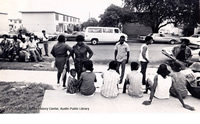 The Austin ISD adopts two alternative desegregation plans, both calling for the closing of Anderson High School and Kealing Junior High. [AF-Segregation-Public Schools-S1700 (2)-1971; The Austin American, “Integration Plans Voted Kealing, Anderson Would Close,” May 06, 1971]
The Austin ISD adopts two alternative desegregation plans, both calling for the closing of Anderson High School and Kealing Junior High. [AF-Segregation-Public Schools-S1700 (2)-1971; The Austin American, “Integration Plans Voted Kealing, Anderson Would Close,” May 06, 1971] |
 |
The government rests its case in federal court after unveiling a plan for busing 13,103 Austin students at an estimated cost of more than $1 million. [AF-Segregation-Public Schools-S1700 (2)-1971; The Austin American, “Government Rests Its Case,” June 18, 1971] |
 |
A United States District judge orders the immediate implementation of the Austin ISD’s desegregation plan. [AF-Segregation-Public Schools-S1700 (2)-1971; The Austin American, “Local Integration Scheme Wins Nod,” July 20, 1971] |
 |
Anderson High School and Kealing Jr. High close September 1.
[AF-Segregation-Public Schools-S1700 (2)-1971; The Austin Citizen, “Busing Plan Evokes Comment,” July 22, 1971] |
 |
The Austin Chapter of the NAACP Legal Defense and Educational Fund says that “if the Justice Department does not appeal the decision in the Austin desegregation case, it will.” [AF-Segregation-Public Schools-S1700 (2)-1971; The Daily Texan, “NAACP Set To Appeal Austin Plan,” August 03, 1971] |
 |
Students at Kealing Junior High and Anderson High School are given counseling to help crossing over proceed smoothly. [AF-Segregation-Public Schools-S1700 (2)-1971; The Austin American, “Students Given Helping Hand In Crossing to New Schools,” August 12, 1971] |
 |
The City of Austin Human Relations Commission issues a statement asking Austinites to support whatever school desegregation plan is implemented in Austin. [AF-Segregation-Public Schools-S1700 (2)-1971; The Austin American, “School Plan Is Supported By the HRC,” August 25, 1971] |
 |
The Austin Chapter of the NAACP and the Mexican American Legal Defense Fund are granted permission by the Fifth U.S. Circuit Court of Appeals to intervene in the Austin school desegregation case pending before the court. [AF-Segregation-Public Schools-S1700 (2)-1971; The Austin American, “2 Groups In School Appeal,” August 25, 1971] |
 |
The Fifth U.S. Circuit Court of Appeals grants a nine-day extension is to the federal government, giving the Department of Health, Education and Welfare until Sept. 3 to file a brief in the Austin school desegregation case. [AF-Segregation-Public Schools-S1700 (2)-1971; The Austin American, “Nine-Day Extension Granted,” August 26, 1971] |
 |
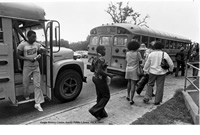 Busing gets off to a smooth start on its first day. [AF-Segregation-Public Schools-S1700 (2)-1971; The Austin American, “Busing Gets Off To Smooth 1st Day,” August 31, 1971]
Busing gets off to a smooth start on its first day. [AF-Segregation-Public Schools-S1700 (2)-1971; The Austin American, “Busing Gets Off To Smooth 1st Day,” August 31, 1971] |
 |
Tension under the strain of forced integration sets off a series of fights and boisterous student confrontations that disrupt A.N. McCallum High School and shut down classes shortly after noon. [AF-Segregation-Public Schools-S1700 (2)-1970s; The Austin American, “Race Tension Sparks Clash,” September 02, 1971] |
 |
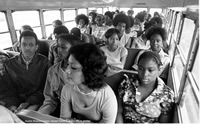 The Federal Justice Department outlines its appeal of the Austin school desegregation plan and agues against excessive busing, a turn in the department’s stance.
[AF-Segregation-Public Schools-S1700 (2)-1971; The Austin American, “Feds Against Heavy Busing,” September 08, 1971]
The Federal Justice Department outlines its appeal of the Austin school desegregation plan and agues against excessive busing, a turn in the department’s stance.
[AF-Segregation-Public Schools-S1700 (2)-1971; The Austin American, “Feds Against Heavy Busing,” September 08, 1971] |
|
|
1972
|
 |
The University of Texas invites the National Congress of Black Professionals to meet at the LBJ Auditorium to discuss problems of blacks in higher education.
[Marsh Durden, Almetris. Overcoming: A History of Black Integration at The University of Texas at Austin. 1979; A 378.76431 DU] |
 |
The U.S. Fifth Circuit Court of Appeals orders a federal plan for desegregation to be submitted; appeals judges issue conflicting opinions and remand the Austin case to federal district court for retrial. [AF-Segregation-Public Schools-S1700 (2)-1972; The Austin American-Statesman (Evening Edition), “Desegregation Chronology,” November 22, 1977] |
|
|
1973
|
 |
The U.S. Department of Health, Education, and Welfare grants Austin ISD half a million dollars to assist in desegregation efforts that will “eliminate, reduce or prevent minority group isolation.” [AF-Segregation-Public Schools-S1700 (2)-1973; Austin American-Statesman, “AISD To Get Federal Grant For Desegregation Efforts,” February 24, 1973] |
 |
Austin ISD Board approves a plan that proposes to request over half a million dollars from Emergency School Assistance Act funds to implement an Austin ISD plan that deals with the isolation of minority students. [AF-Segregation-Public Schools-S1700 (2)-1973; The Austin American, “Austin Trustees Approve Plan On District Desegregation,” April 26, 1973] |
 |
Austin ISD again faces charges of discrimination in district court when the Fifth U.S. Circuit Court of Appeals overturns District Judge Jack Roberts’ original decision that “no discrimination against Mexican Americans existed in Austin.” [AF-Segregation-Public Schools-S1700 (2)-1973; The Daily Texan, “AISD Faces Charges Again,” May 07, 1973] |
 |
The Mexican American Legal Defense Fund presents a study in the Austin school desegregation case that indicates that the restrictive covenants that have existed in the city from 1923-1960 contributed to the racially segregated housing patterns in the city. Although no longer legal, the covenants historically have “disallowed total freedom of choice in the area of residential site selection.” [AF-Segregation-Public Schools-S1700 (2)-1973; Austin American-Statesman, “Housing Pattern Linked to Deeds,” May 12, 1973] |
 |
Austin sixth graders will attend one of eight specially integrated centers that represent the heart of a school desegregation plan filed by the Austin ISD in District Court. [AF-Segregation-Public Schools-S1700 (2)-1973; The Austin American, “Okayed School Plan Centers On Integrating 6th Graders,” August 02, 1973] |
 |
Parents from two prospective sixth-grade schools submitted alternative desegregation plans to Austin ISD Board of Trustees, which will keep their schools grades kindergarten through five. [AF-Segregation-Public Schools-S1700 (2)-1973; Austin American-Statesman, “Sixth Graders’ Parents Give Alternate Desegregation Plan,” August 12, 1973] |
|
|
1974
|
 |
Six 6th grade centers open at the start of the school year.
[AF-Segregation-Public Schools-S1700 (2)-1974; The Austin American-Statesman (Evening Edition), “Desegregation Chronology,” November 22, 1977] |
 |
A hearing is held in federal court on the proposed construction of Sanchez, Houston and Williams elementary schools; construction is delayed due to government and intervenor objections. [AF-Segregation-Public Schools-S1700 (2)-1974; The Austin American-Statesman (Evening Edition), “Desegregation Chronology,” November 22, 1977] |
 |
Intervenors agree to proposed sites for Williams, Sanchez and Houston elementary schools and construction begins. Austin ISD submits proposals for a new southwest high school and northeast junior high, and the government objects to both. [AF-Segregation-Public Schools-S1700 (2)-1974; The Austin American-Statesman (Evening Edition), “Desegregation Chronology,” November 22, 1977] |
|
|
1975
|
 |
The Austin Chapter of the NAACP criticizes proposed Oak Hill site for a southwest high school. [AF-Segregation-Public Schools-S1700 (2)-1975; The Austin Citizen, “Segregation ‘Seeds’ Will Surely Grow,” May 17, 1975] |
 |
The school district’s new transfer policy sparks a movement by parents to begin registering their children in schools with low enrollments, but it did not result in an exodus from the campuses labeled the “least fundamental” in the city by the Awareness League, an Austin based organization that advocates for a more disciplined and structured school environment. Under the policy, Trustees designated A.N. McCallum High, Lamar and O. Henry Junior High, and 13 elementary schools as “open enrollment schools,” and agreed to accept all student transfers to those facilities, as long as the parents or students provide their own transportation. [AF-Segregation-Public Schools-S1700 (2)-1975; The Austin Citizen, “Transfer Rule Gets Response,” May 31, 1975] |
 |
Austin ISD files an answer to proposed sites for Williams, Sanchez and Houston elementary schools and construction begins. Austin ISD proposes constructing northeast junior high school, but intervenors object. Austin ISD makes plans for a new southwest high school, but intervenor dissatisfaction prompts district to postpone hearing in federal court. [AF-Segregation-Public Schools-S1700 (2)-1975; The Austin American-Statesman, “Desegregation in Austin,” August 17, 1975] |
|
|
1976
|
 |
The Black Business Association forms at The University of Texas at Austin to provide a means for students in the College of Business to network. [Marsh Durden, Almetris. Overcoming: A History of Black Integration at The University of Texas at Austin. 1979; A 378.76431 DU] |
 |
U.S. District Judge Jack Roberts appoints 21 persons to serve on a tri-ethnic committee to help plan Austin’s school integration. [AF-Segregation-Public Schools-S1700 (2)-1976; The Austin Citizen, “21 Named to Deseg Panel,” July 02, 1976] |
 |
In May, the Fifth U.S. Circuit Court of Appeals remands the Austin ISD plan back to a local federal judge, in effect calling for further desegregation and possible abolition of sixth-grade schools. Heated community reaction follows in wake of the federal appeals decision. The school district appeals to the U.S. Supreme Court. [AF-Segregation-Public Schools-S1700 (2)-1976; The Austin American-Statesman (Evening Edition), “Desegregation Chronology,” November 22, 1977] |
 |
In December, the Supreme Court strikes down the school desegregation order issued by the appeals court, and most plans in the district for top-to-bottom desegregation are halted. The case is sent back to the Fifth U.S. Circuit Court of Appeals with an order from the Supreme Court to review the previous order. [AF-Segregation-Public Schools-S1700 (2)-1976; The Austin American-Statesman (Evening Edition), “Desegregation Chronology,” November 22, 1977] |
|
|
1977
|
 |
The Austin Chapter of the NAACP calls for the removal of a Burnet Junior High School assistant principal they label as “rude, insensitive and sarcastic to students and parents.” [AF-Segregation-Public Schools-S1700 (2)-1977; The Austin Citizen, “Ouster of School Official Sought,” April 18, 1977] |
 |
On November 21, the Fifth U.S. Circuit Court of Appeals rules for the third time that the Austin district intentionally segregates its Chicano students, and sends the case once again to federal district court for rehearing. The Austin desegregation case is now seven years old. [AF-Segregation-Public Schools-S1700 (2)-1977; The Austin American-Statesman (Evening Edition), “Desegregation Chronology,” November 22, 1977] |
 |
A retrial is held in federal district court, and the judge finds that there is no unlawful segregation against Mexican American students. He orders the creation of sixth-grade learning centers to desegregate that grade and orders AISD to request approval of construction of new schools by intervenors (NAACP and Mexican American Legal Defense Education Fund). Intervenors and the government file appeal briefs with the Fifth Circuit Court of Appeals. [AF-Segregation-Public Schools-S1700 (2)-1977; The Austin American-Statesman (Evening Edition), “Desegregation Chronology,” November 22, 1977] |
|
|
1978
|
 |
Two Mexican American organizations band together in an effort to unify Austin Chicanos on school desegregation and other educational issues. A 12-member task force is organized to find out how Mexican-Americans feel about their public schools and how to make those feelings known. [AF-Segregation-Public Schools-S1700 (2)-1978; The Austin American-Statesman, “Groups Plan Joint Desegregation Push: Chicano Unity Sought on School Issue,” February 05, 1978] |
|
|
1979
|
 |
A coalition of Mexican American groups charges Austin ISD with negotiating in bad faith on desegregation and said the issue will have to be settled in court. [AF-Segregation-Public Schools-S1700 (2)-1979; The Austin Citizen, “AISD Accused of Bad Faith in Desegregation,” May 30, 1979] |
 |
Austin School officials express disappointment and confusion at the Supreme Court’s decision to let stand a lower court ruling that the AISD intentionally discriminated against Mexican Americans in drawing up its desegregation plans. [AF-Segregation-Public Schools-S1700 (2)-1979; The Daily Texan, “Supreme Court Rules that AISD was Discriminatory,” July 03, 1979] |
 |
The first day of the federal district court “remedy trial” begins in Austin desegregation case. The two-fold purpose of the trial is to determine the extent of the Austin ISD’s constitutional violations in segregating blacks and Mexican Americans and to prescribe a remedy in the form of a desegregation plan. [AF-Segregation-Public Schools-S1700 (2)-1979; The Austin Citizen, “AISD Desegregation ‘Remedy Trial’ Begins,” July 11, 1979] |
 |
An Austin ISD attorney disputes testimony that school board actions are a significant factor in housing segregation. [AF-Segregation-Public Schools-S1700 (2)-1979; The Austin Citizen, “District Disputes Its Policies Spurred Housing Segregation,” July 24, 1979] |
 |
An urban planning expert disputes testimony by school district witnesses that economic factors are overriding causes of segregated housing. [AF-Segregation-Public Schools-S1700 (2)-1979; The Austin Citizen, “Urban Planner Blames AISD for Segregation,” July 25, 1979] |
 |
The parties to the Austin desegregation lawsuit prepare to file a consent decree in the federal district court, ending nearly 9 ½ years of litigation. [AF-Segregation-Public Schools-S1700 (2)-1979; The Austin Citizen, “15,000 to be Bused; Deseg Agreement Reached; Judge Roberts to Get Proposal,” December 17, 1979] |
 |
Approximately 300 Anderson High School students storm the Carruth Administration building, waving anti-busing signs, chanting “Hell, no, we won’t go.” [AF-Segregation-Public Schools-S1700 (2)-1979; The Austin Citizen, “300 Storm Carruth Building; Students: We Won’t Go,” December 10, 1979] |
|
|
1980
|
 |
U.S. District Judge Jack Roberts gives final approval to the consent decree settling Austin’s decade long desegregation suit. [AF-Segregation-Public Schools-S1700 (2)-1980; The Austin Citizen, “Judge Puts OK On AISD Busing Plan,” January 03, 1980] |
 |
Various churches in Austin hear support for peaceful implementation of a desegregation plan and opposition to civil disobedience. [AF-Segregation-Public Schools-S1700 (2)-1980; The Austin Citizen, “Pastors Plea for Deseg Calm,” January 14, 1980] |
 |
 Approximately 150 irate, distraught Austin parents meet with U.S. Representative Jake Pickle to ask his support for anti-busing legislation. [AF-Segregation-Public Schools-S1700 (2)-1980; The Austin Citizen, “Pickle Conference Leaves Anti-busers Frustrated,” January 21, 1980]
Approximately 150 irate, distraught Austin parents meet with U.S. Representative Jake Pickle to ask his support for anti-busing legislation. [AF-Segregation-Public Schools-S1700 (2)-1980; The Austin Citizen, “Pickle Conference Leaves Anti-busers Frustrated,” January 21, 1980] |
 |
The Austin school board votes unanimously to recommend legislation providing state aid to districts with declining enrollment because of court-ordered desegregation. [AF-Segregation-Public Schools-S1700 (2)-1980; The Austin Citizen, “AISD to Ask Aid for Deseg-rifled districts,” January 27, 1980] |
 |
The Austin school board studies a revised transfer policy aimed at preventing the disruption of student assignment patterns under desegregation. [AF-Segregation-Public Schools-S1700 (2)-1980; The Austin Citizen, “School Transfers May End,” February 13, 1980] |
 |
The Austin school board agrees to take several proposed desegregation changes to the Intervenors in the desegregation lawsuit. [AF-Segregation-Public Schools-S1700 (2)-1980; The Austin Citizen, “Board to Seek Adjustments in Busing Plan,” March 04, 1980] |
 |
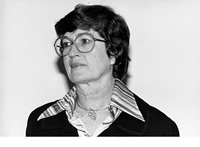 Anti-busing sentiment and a low voter turnout characterize an Austin Independent School Board election which result in the defeat of school trustee DeCourcy Kelley running in Place 2. [AF-Segregation-Public Schools-S1700 (2)-1980; The Daily Texan, “Busing Issue Critical in School Board Election,” April 07, 1980]
Anti-busing sentiment and a low voter turnout characterize an Austin Independent School Board election which result in the defeat of school trustee DeCourcy Kelley running in Place 2. [AF-Segregation-Public Schools-S1700 (2)-1980; The Daily Texan, “Busing Issue Critical in School Board Election,” April 07, 1980] |
 |
Fall enrollment at Austin’s private schools increases because of court-ordered desegregation. [AF-Segregation-Public Schools-S1700 (2)-1980; The Daily Texan, “Busing Spurs Exit to Private Schools,” September 10, 1980] |
|
|




















